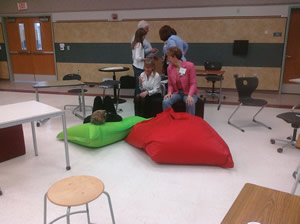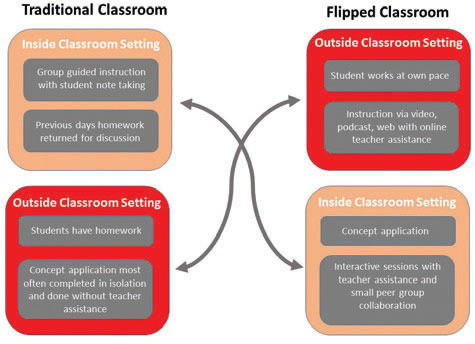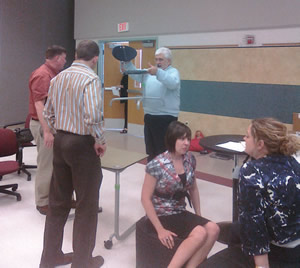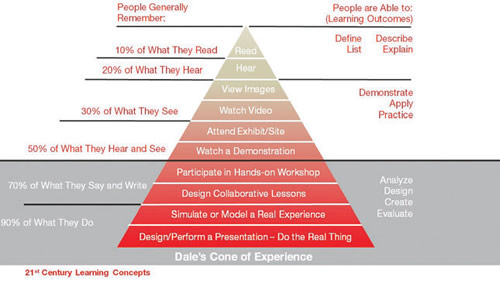Flipping for Student Success

PHOTOS COURTESY OF thinkSMART PLANNING, INC.
School furniture is an important component in creating effective 21st-century learning environment. It is a key consideration in implementing a flipped teaching and learning strategy.
It was in 2007 when teachers Jonathan Bergman and Aaron Sams, at Colorado’s Woodland Park High School, discovered software to record their PowerPoint presentations and posted these live lectures on-line. The focus of this teaching and learning strategy was to “lecture” outside of the class period and reserve the class time for collaborative activity on concept application and mastery. Students no longer had to struggle in isolation at home on nightly homework trying to apply what had been presented earlier in the daily teacher lecture. The advances of technology and wider access of handheld/personal devices have provided the framework for the lectures to now be delivered by video podcast, apps or online videos. New classroom management and instructional software are also giving more instructional options for teachers such as flipped classrooms.
And while it is called a “flipped” classroom, it is not a destination down the hall nor is it a curriculum offering. It is a different framework from traditional classroom of how and where instruction is presented and where and how it is applied. It is where students watch lectures at home at their own pace, communicating with teachers and peers via online discussions, and then are engaged in the classroom applying the concept with the aid of peers and instructor. It is a change in the instructional strategies of how and when, it is a change in the classroom culture, and to be most effective, it calls for a change in the context of the learning environment itself.
In the words of Dr. Tim Springer, of Hero, Inc., “Environment is not neutral, it has either positive or negative impact, it is not just background, it is where we are, we experience life in and interacting with spaces and places, environment is context and context gives meaning. Effective built environments accommodate user behaviors and adapt to the immediate need — in a word they are agile. Agility is much more than flexibility. As a design goal, flexibility leads to solutions that try to be all things to all people and do nothing well. Agile solutions are purposeful and easily adapted to a set to defined need.”

The role of furniture
Too often, furniture is viewed only as a commodity, responding to the seat time requirements and bid procedures of the business office, thus becoming an afterthought and selected outside of the design process. Furniture is a vital component of creating the 21stcentury teaching and learning environments.
Flipped classrooms, project-based learning, authentic and learner-centered spaces all benefit from thoughtful planning. To define the needs of the learning context, it is important to engage stakeholders.
In school planning workshops, Molly Smith, of thinkSMART planning, shares that she frequently works with clients to establish the key qualities and requirements of the learning process.
A case study example would be Leander Independent School District located in central Texas. They identified their key qualities of an effective learning environment with the following criteria.
- Flexibility: Provide and encourage a wide variety of learning settings and learning strategies (i.e., individual, team, small group, large group, formal, informal, community) and flexibility and ease of adaptation in learning settings.
- Integration: Provide for the integration of subjects, learning modes, technology, grade levels within the classroom, grade level and specialty areas.
- Hands-On Learning: Support hands-on learning through curriculum, classroom size and configuration, furnishings and equipment and group learning areas, both indoor and outdoor.
- Small(er) Learning Communities: It is the committee’s recommendation to adhere to the 800-student maximum enrollment at each elementary school. Additionally, the committee recommends “clustering of classrooms.” The new elementary should support small learning communities through space and amenities
provided to each cluster.
- Push-In vs. Pull- Out: Whenever possible, resource programs, materials and support should be “pushed-in” to the classroom and integrated with the daily classroom curriculum. Space, amenities and staff should be provided to achieve this goal.
In order to support these key concepts, the learning environment had to be flexible and agile, durable and modern. Accordingly, the furnishings are a key part of this equation. Without the appropriate furnishings, students and teachers are unable to fully realize their educational vision. But the array of furnishing choices is dizzying. Educators and school purchasing officials have many, many choices and often not enough time to try them all.
One of the tools planners at thinkSMART planning used during the planning sessions with Leander ISD was the “furniture tour,” both virtually and literally.

Furniture Tour. One of the tools used during the planning sessions with Leander ISD was the furniture tour. In the photo above, Jim Brady talks with participants about how adaptable furniture and furnishings affect the learning process. To create a learning environment that is interactive, personal, collaborative and learner-focused for the flipped classroom furniture solutions need to be agile.
In the virtual tour, Smith states that they built team members’ palettes by sharing images of various types of flexible and adaptable furniture. “We looked at furniture for work, play, technology, dining and a variety of other activities. During planning sessions, we reached out to local school furniture vendors to provide samples of furnishing to us as props and demonstrations with team members,” she explains.
“‘Learning scenarios’ are then created to challenge the educators and purchasing personnel to create appropriate learning environments from the multitude of furniture prop. Understanding how furniture impacted the learning process, both positively or negatively, is important for all to experience early in the planning process,” she continues.
“But it is the obvious that often eludes us,” Smith says, “as we are all limited in that we only know what we know, and a virtual workshop is but one way to experience other choices without an airplane ticket or trip to a school furniture expo. To create a contextual learning environment that is interactive, personal, collaborative and learner-focused for the flipped classroom furniture calls for agile solutions.”
R.J. Webber is the assistant superintendent for Curriculum with the Novi Community Schools in the Detroit metro area. He says the schools are having success with flipped classrooms and he offers the following advice.
- Furniture needs to be light enough to be moved by students to form smaller collaborative areas.
- Table tops need to be wider (for both a book and iPad or tablet computer) and table tops should be capable of being linked together,
- All furniture should have casters to aid in reconfiguring the room, maybe as many as three times a class period.
Flipped classroom methods provide classroom activity that is hands-on, collaborative and involves peer group presentation where students are analyzing, designing, creating and evaluating. These activities result in a 70 to 90 percent retention by the students as shown in Dale’s Cone of Experience.

The increasing implementation of flipped classrooms across the country is being driven by several factors. First and foremost is the continued failure of a traditional one-size-fits-all instructional model. The flipped classroom changes the delivery and level of engagement in the classroom. An added bonus is that flipping gives the teacher more actual class time to spend one-on-one with students.
Also, flipped classrooms increase student access to personal computing devices and the expanded availability of online resources to supplement those created by the class instructor. For example, the Kahn Academy’s Library (www.khanacademy.org) has more than 6,500 free videos covering a variety of topic areas in 23 languages.
As an emerging instructional strategy, flipped classrooms are making a positive learning difference. School facility planners and designers need to champion the idea that learning environments are not neutral in the learning experience and that furniture is an effective design component used to provide context in the built environment. For flipped classrooms to be effective, it will take more than casters on the chairs and a smartphone in the backpack. What is essential is a redefined focus on a student-centered environment.
This article originally appeared in the issue of .